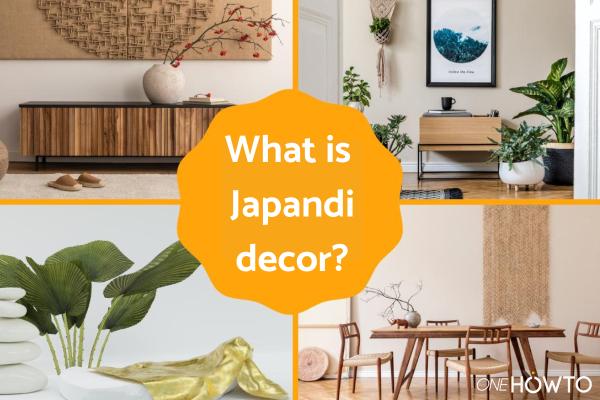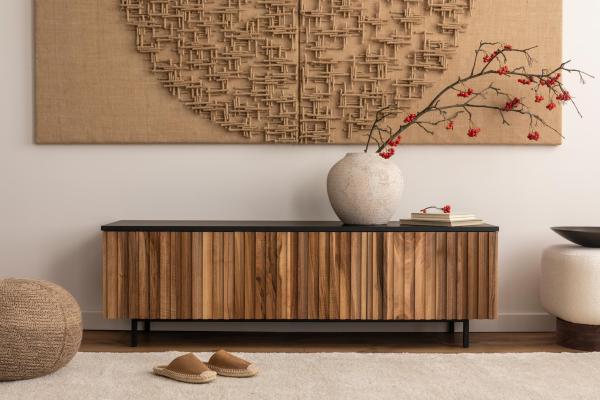
A new interior decoration concept that has become popular in recent months is the Japandi style, a popular choice for renovating your home or transforming a specific room. Japandi style is a design trend that combines elements of Japanese minimalism with Scandinavian design principles. It is a fusion of two distinct design philosophies that share a similar focus on simplicity, functionality, and natural materials.
The following oneHOWTO article explains what the Japandi style is and what its principles are. We also give you some decorating ideas.
What is the Japandi style?
The term "Japandi" is a combination of "Japan" and "Scandinavia," reflecting the fusion of these two styles. The principles of Japandi style are rooted in the design philosophies of Japanese minimalism and Scandinavian design. Here are some of the main principles of Japandi style:
- Minimalism: Japandi style emphasizes a clean and uncluttered look. The emphasis is on simplicity, with a limited number of accessories and decorative elements.
- Natural materials: the use of natural materials is an important aspect of the Japandi style. Materials such as wood, bamboo, leather and stone are used to create a warm and inviting atmosphere.
- Practicality: the design of the Japandi style focuses on functionality. Furniture is often close to the floor and designed to be comfortable and practical.
- Neutral color palette: Japandi style is characterized by a neutral color palette of white, gray, and natural wood tones. These colors create a calm and serene environment.
- Clean Lines: The design esthetic of the Japandi style features clean lines and simple shapes. This creates a harmonious and balanced look.
- Wabi-Sabi: The Japandi style draws on the Japanese philosophy of wabi-sabi, which celebrates the beauty of imperfection and impermanence.
Following our discussion of the principles of Japandi decor, we will now discuss its defining elements and characteristics.
The furniture is practical and functional
Furniture in Japandi style is typically designed with functionality and simplicity in mind. The main material of Japandi style is wood, which can be seen in the furniture, shelving units, headboards, and floors. The preferred wood is light tones. Other materials that are often used are bamboo and leather. These materials create a warm and inviting atmosphere in the space.
Furniture in Japandi style is often designed to be low to the ground, creating a sense of groundedness and stability. Japandi furniture also features clean lines and simple shapes. This creates a sense of balance and harmony in the space.
Japandi furniture is designed to be practical and functional. It is often multi-purpose, with built-in storage and other features that maximize its utility.

Incorporating the outdoors into the home
Nature plays a central role in the Japandi style, as the design philosophy is based on the idea of creating a link between the interior and the exterior. Japandi style embraces natural materials, colors and textures, bringing the outdoors into the home.
As mentioned earlier, Japandi style emphasizes the use of natural materials to bring a sense of warmth and texture to the space while creating a connection between the interior and the natural world. Japandi style is characterized by a neutral color palette of white, gray, and natural wood tones to reflect the colors of nature and create a sense of calm and serenity in the room.
Plants play an important role in this style and bring a touch of nature to your home. Plants are often used as decorative elements that give the room a sense of life and vitality.
Japandi style often includes large windows and other design elements that provide a view of the outdoors. This helps create a sense of connection to the natural world, even when you are indoors.
This style also seeks to incorporate organic shapes, such as rounded edges and curves. These shapes reflect those found in nature and create a sense of harmony and balance in the space.
Do not miss this other article where we discuss which low light plants are best for your home.

Textiles plays a key role
Textiles are an important element in Japandi style, as they add warmth, texture, and color to the space. Here are some ways in which textiles are incorporated into Japandi style:
- Natural materials: Like furniture and other design elements, textiles are often made from natural materials such as cotton, linen, and wool. These materials bring a sense of warmth and texture to the space, while also connecting the interior to the natural world.
- Simple patterns: Textiles feature simple, understated patterns such as stripes or geometric shapes. This creates a sense of calm and serenity in the space.
- Neutral colors: Japandi style typically features a neutral color palette of whites, grays, and natural wood tones. Textiles in these colors reflect the colors of nature, creating a sense of harmony in the space.
- Layering: this style often incorporates layers of textiles, such as a throw blanket on a sofa or a rug on the floor. This adds depth and dimension to the space, while also creating a cozy and inviting atmosphere.
- Textured fabrics: Textures play an important role, as they add visual interest and depth to the space. Textured fabrics such as bouclé or nubby wool are typically used to create a tactile experience.
- High-quality materials: this style emphasizes the use of high-quality materials, including textiles. This helps to create a sense of luxury and comfort in the space.
Craftsmanship is highly valued and celebrated
In both Japanese and Scandinavian cultures, craftsmanship is highly valued and celebrated. Traditional Japanese crafts such as pottery, lacquerware, and textiles are known for their meticulous attention to detail and exquisite beauty. Scandinavian design also places a high value on craftsmanship, emphasizing well-made, functional objects made to last.
Handmade objects such as ceramics and textiles play an important role in Japandi design, adding warmth and texture to the clean, minimalist esthetic.
Overall, craftsmanship and Japandi design are closely linked, as both emphasize the importance of skill, attention to detail, and a commitment to excellence in creating beautiful, functional objects.

If you want to read similar articles to What is Japandi? - Definition, Principles and Keys, we recommend you visit our Interior Design and Decor category.